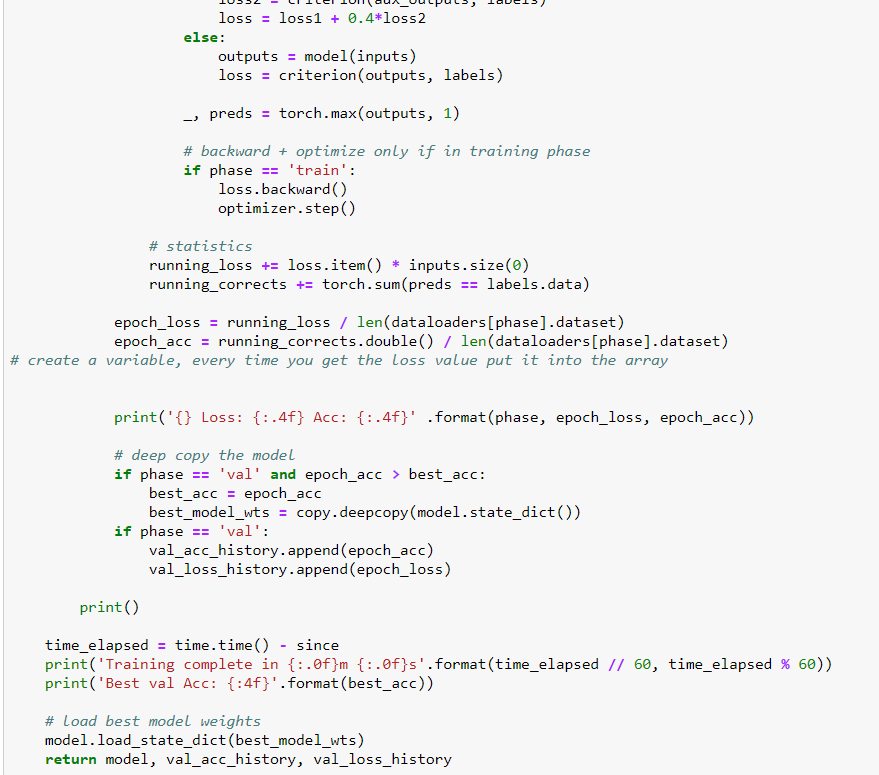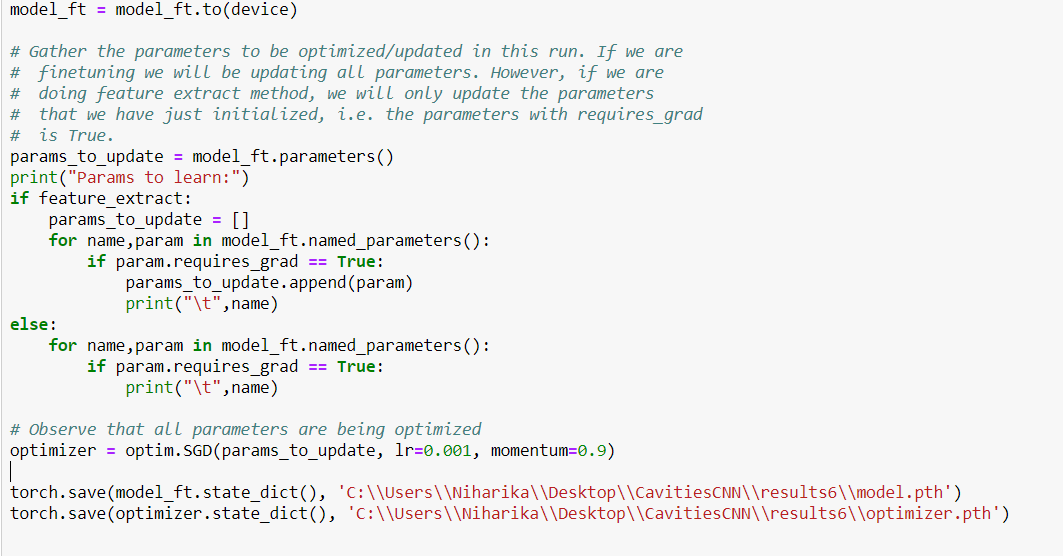Thanks. I tried by adding these lines:
if phase == 'val' and epoch_acc > best_acc:
best_acc = epoch_acc
best_model_wts = copy.deepcopy(model.state_dict())
if phase == 'val':
val_acc_history.append(epoch_acc)
val_acc_history.append(epoch_loss)
elif phase == 'train':
train_acc_history.append(epoch_acc)
train_acc_history.append(epoch_loss)
....
....
model_ft, hist = train_model(model_ft, dataloaders_dict, criterion, optimizer_ft, num_epochs=num_epochs, is_inception=(model_name=="inception"))
torch.save(model_ft.state_dict(), 'googlenet/standard_googlenet.pth')
ohist = []
#shist = []
ohist = [h.cpu.numpy() for h in hist]
#shist = [h.cpu().numpy() for h in train_model.epoch_loss]
plt.title("Loss&Acc Vs. Number of Training Epochs")
plt.xlabel(" Epochs")
plt.ylabel("Accuracy & Loss")
plt.plot(range(1,num_epochs+1),ohist,label="Training Accuracy")
plt.plot(range(1,num_epochs+1),ohist,label="Training Loss")
plt.plot(range(1,num_epochs+1),ohist,label="Validation Accuracy")
plt.plot(range(1,num_epochs+1),ohist,label="Validation Loss")
plt.ylim((0,1.))
plt.xticks(np.arange(1, num_epochs+1, 1.0))
plt.legend()
plt.savefig('plots.png')
plt.show()
but it throws an error:
Traceback (most recent call last):
File "ftune.py", line 284, in <module>
model_ft, hist = train_model(model_ft, dataloaders_dict, criterion, optimizer_ft, num_epochs=num_epochs, is_inception=(model_name=="inception"))
ValueError: too many values to unpack (expected 2)
I tried also TensorboardX, like these snippets:
from tensorboardX import SummaryWriter
writer = SummaryWriter('runs')
...
...
def train_model(train_loader, model, criterion, optimizer, epoch):
if i % args.print_freq == 0:
print('Epoch: [{0}][{1}/{2}]\t'
'Time {batch_time.val:.3f} ({batch_time.avg:.3f})\t'
'Data {data_time.val:.3f} ({data_time.avg:.3f})\t'
'Loss {loss.val:.4f} ({loss.avg:.4f})\t'
'Prec@1 {top1.val:.3f} ({top1.avg:.3f})\t'
'Prec@5 {top5.val:.3f} ({top5.avg:.3f})'.format(
epoch, i, len(train_loader), batch_time=batch_time,
data_time=data_time, loss=losses, top1=top1, top5=top5))
niter = (epoch * len(train_loader))+i
writer.add_scalar('Train/Loss', losses.val, niter)
writer.add_scalar('Train/Prec@1', top1.val, niter)
writer.add_scalar('Train/Prec@5', top5.val, niter)
def validate(val_loader, model, criterion):
if i % args.print_freq == 0:
print('Test: [{0}/{1}]\t'
'Time {batch_time.val:.3f} ({batch_time.avg:.3f})\t'
'Loss {loss.val:.4f} ({loss.avg:.4f})\t'
'Prec@1 {top1.val:.3f} ({top1.avg:.3f})\t'
'Prec@5 {top5.val:.3f} ({top5.avg:.3f})'.format(
i, len(val_loader), batch_time=batch_time, loss=losses,
top1=top1, top5=top5))
niter = epoch*len(train_loader)+i
writer.add_scalar('Test/Loss', losses.val, niter)
writer.add_scalar('Test/Prec@1', top1.val, niter)
writer.add_scalar('Test/Prec@5', top5.val, niter)
but in validate function it throws an error like epoch is not defined etc.
could you share some snippets for TensorboardX?




